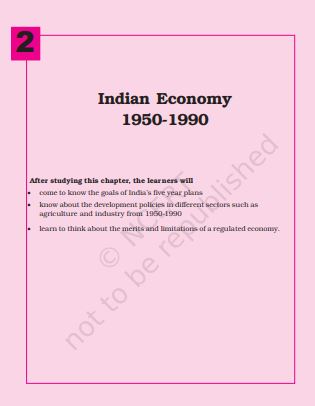‘NCERT Solutions for Class 11 Economics Chapter 2 Indian Economy 1950 – 1990‘ PDF Quick download link is given at the bottom of this article. You can see the PDF demo, size of the PDF, page numbers, and direct download Free PDF of ‘Ncert Class 11 Economics Chapter 2 Exercise Solution’ using the download button.
Indian Economy (1950 – 1990) NCERT Textbook With Solutions Book PDF Free Download

Chapter 2: Indian Economy 1950 – 1990
On 15 August 1947, India woke to a new dawn of freedom. Finally we were masters of our own destiny after some two hundred years of British rule; the job of nation-building was now in our own hands.
The leaders of independent India had to decide, among other things, the type of economic system most suitable for our nation, a system that would promote the welfare of all rather than
a few. There are different types of economic systems (see Box 2.1) and among them, socialism appealed to Jawaharlal Nehru the most.
However, he was not in favor of the kind of socialism established in the former Soviet Union where all the means of production, i.e. all the factories and farms in the country, were owned by
the government.
There was no private property. It is not possible in a democracy like India for the government to change the ownership pattern of land and other properties of its citizens in the way that it was
done in the former Soviet Union.
Nehru, and many other leaders and thinkers of the newly independent India, sought an alternative to the extreme versions of capitalism and socialism.
Basically sympathizing with the socialist outlook, they found the answer in an economic system that, in their view, combined the best features of socialism without its drawbacks.
In this view, India would be a socialist society with a strong public sector but also with private
property and democracy; the government would plan the economy with the private sector being
encouraged to be part of the planning effort.
The ‘Industrial Policy Resolution’ of 1948 and the Directive Principles of the Indian Constitution reflected this outlook. In 1950, the Planning Commission was set up with the Prime Minister as its Chairperson. The era of five-year plans had begun.
| Author | NCERT |
| Language | English |
| No. of Pages | 20 |
| PDF Size | 0.6 MB |
| Category | Economics |
| Source/Credits | ncert.nic.in |
NCERT Solutions Class 11 Economics Chapter 2 Indian Economy 1950 – 1990
1. Define a plan.
Plan is referred to as the list of actionable goals and specific objectives that a nation wants to achieve over a specific period of time.
2. Why did India opt for planning?
After achieving independence in 1947, India was faced with the task of reviving the poor, backward state in which the colonial government had left India. Efforts were made to solve people’s problems through a democratic government.
A country is said to be on the path of development when there is economic prosperity. To attain that prosperity, Planning Commission was set up in 1950 for establishing a development framework for the nation where both public and private sectors would contribute toward economic development.
3. Why should plans have goals?
A plan without a goal is like a ship without a radar. The plan specifies ways in which resources need to be allocated in order to achieve the target which is defined by goals. Goals are achievements that help us visualize the successful execution of plans. Thus goals are a must-have in planning.
4. What are high Yielding Variety (HYV) seeds?
These are the seed varieties that have high-yielding characteristics. The seeds produce more crops than the normal varieties.
Seeds need proper irrigation facilities along with more fertilizers and pesticides in order to get the best yield. HYV seeds grow at a faster rate than the normal varieties and are able to generate 10-20 times more crop per hectare than normal varieties.
5. What is a marketable surplus?
The portion of the harvest that a farmer can sell in the market in order to earn a profit is known as Marketable Surplus. The profit thus earned can be reinvested into farming operations.
NCERT Class 11 Economics Textbook Chapter 2 With Answer PDF Free Download
